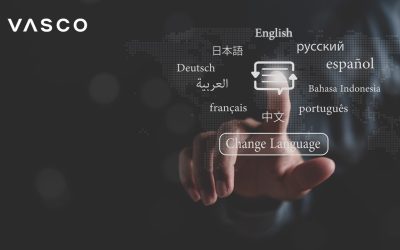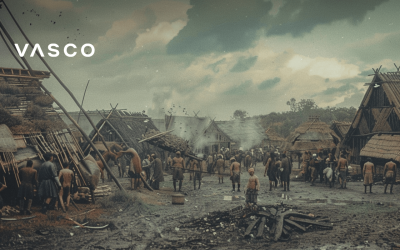Do you like learning fictional languages? Do you study the vocabulary of Klingon, the pronunciation of Dothraki, or the grammar of Na’vi?
Well, then you should know that all fictional languages we know today were inspired by the work of J.R.R. Tolkien, a mastermind behind the world of Middle-earth.
So, what language did Tolkien come up with? Or, maybe there was more than one?
J.R.R. Tolkien is thought to be an inventor of artistic languages in general. These linguistic constructs are supposed to be as convincing as real-world languages, so they usually have their own vocabulary, grammar, and history.
FAQ:
Is Tolkien’s Elvish a real language?
What is the main language in Lord of the Rings?
What language do the Teleri speak?
What is the secret language of the Dwarves?
How do you say hello in Khuzdul?
And while Tolkien first started creating Elvish languages (such as Quenya, Telerin, and Eldarin), he also needed to create a human language, as well as dwarven and orcish languages in order to fulfill the narrative of Middle-earth.
Taking all that into account, we can say that the other writers had pretty solid source material when they were creating their own tongues.
So, anyway, here are the questions we will try to answer:
- What is Quenya?
- What is Sindarin?
- What is Telerin?
- What is Avarin?
- What is Nandorin?
- What is Eldarin?
- What is the Black Speech of Mordor?
- What is Khuzdul?
- What is Westron?
- What Tolkien language can readers actually learn to speak?
Wherever possible, we’ll also try to answer the following question: what are the languages based off of in Lord of the Rings? And we mean, real-world languages.
What we listed above are not all languages in Middle-earth. They are, however, the most well-known. Tolkien probably created over 15 fictional languages.
In this article, we will look into each of the above topics briefly. If you want to read an in-depth analysis of some of these fictional languages, read an article about Quenya and the Black Speech of Mordor.

Table of Contents:
First, let’s explain something…
Tolkien created a very rich world that may seem more diverse and odd than the world we’re actually living in! Not only did he put Elves, Orcs, and other magical creatures in his stories, but he also gave them a rich history that wouldn’t fit a normal-sized book.
Thus, when talking about the languages of Middle-earth, we may mention some unknown terms that are important for the history of this world. One of them is the Great Journey.
The Great Journey (also known as the Great March) was the journey of the Elves called Eldar that they undertook from Cuiviénen (the place of their awakening that happened long before the First Age) to Valinor. It is believed that they walked a distance of 2000 miles for almost 50 years.
Let’s also bear in mind that the history of Middle-earth consists of three long ages: the First Age, the Second Age, and the Third Age.
- The Third Age is the time when both The Hobbit and The Lord of the Rings happened. It ended when the One Ring was destroyed.
- The Second Age is mentioned at the beginning of The Fellowship of the Ring movie (the War of the Last Alliance).
- The First Age was largely described in The Silmarillion (the War with Morgoth — the Dark Lord who had ruled long before Sauron did).
Also, where did all the languages come from? According to the Lhammas, a fictional sociolinguistic paper written by Tolkien, they all came from the one language spoken by angelic beings called Valar.
Later, Tolkien revised the internal history and claimed that Elves were able to construct their own languages. He never updated the Lhammas though.

Quenya — The Speech of High Elves
The Quenya language is Middle-earth’s equivalent of Latin. It was used in ancient times but got replaced by newer languages. Later, Quenya was used only by scholars and for ceremonial purposes. Here’s how that happened…
Some marched to Valinor (Middle-earth’s equivalent of Heaven) and some returned to Middle-earth. Those who marched to Valinor developed the Quenya language, whereas Noldor, who returned to Middle-earth, adopted Sindarin from the Grey Elves.
The clans from the land of the Lord of the Rings used Sindarin as their primary language, whereas Quenya was only used for ceremonial, ritual, and poetic purposes.
The Quenya language was commonly associated with the High Elves and the firstborn. It was partly because of the language’s close association with Valinor. Its decreasing use also symbolized the vanishing Elvish culture in Middle-earth.
Quenya was also spoken by Valar, Middle-earth’s angelic beings who served Eru Ilúvatar, Tolkien’s equivalent of the Christian God.
This language of High Elves was featured prominently in The Lord of the Rings in a form of poems and dialogues.
Below, you can see a table featuring some vocabulary of this ancient speech:
Quenya |
English |
| aika | broad, vast |
| aina | holy |
| ailo | lake, pool |
| haimë | habit |
| halcin | frozen |
| imbë | between |
| indo | house |
| tassë | there |
| ráva | wilderness |
| carma | weapon |
Sindarin — The language of Grey Elves
In the world of The Lord of the Rings, this is a language most commonly associated with Elves. It is usually referred to simply as Elf-Tongue or Elven-Tongue.
As we mentioned earlier, the Noldor who returned to Middle-earth adopted Sindarin as their primary language, whereas Quenya remained a written and ceremonial tongue.
Sindarin was also spoken by humans. In the Second Age, it was used by the Men of Númenor, who could speak it fluently.
Later, in the Third Age, Sindarin was spoken by descendants of Númenorians — the Dúnedain of Gondor and Arnor.
It is worth noting that Sindarin was one of the languages spoken in the Lord of the Rings movies. We can read it in the books as well.

Telerin — one of the oldest languages of Middle-earth
This is a tongue related to Quenya and Sindarin. Also called Lindalambe or Lindárin, it was used by Falmari — Teleri (the third of the Elf clans who took the Great Journey) who took part in the Journey and eventually reached Valinor.
Telerin was considered to be a dialect of Quenya. There are, however, some notable differences between Telerin and Quenya.
For example, the possessive endings in Telerin are suffixed to a word of something possessed, not possessing, as opposed to Quenya. What’s more, the phonology of Telerin was vastly different from that of the Quenya language.
Also, there was a time in the history of Middle-earth when the speakers of Telerin outnumbered the speakers of Quenya.
Avarin — a group of ancient Elvish tongues
The Avarin group consisted of at least six different languages. Even though they all descended from Primitive Quendian, which is a big Elvish proto-language, they didn’t have much in common. It is also known that Avarin is divided into three larger groups: West Avarin, North Avarin, and East Avarin.
When it comes to the name of the language itself, we know that Avarin is a Quenya word meaning the language of the refusers or the language of those who did not travel to Avar.
Nandorin — the language of Elves who broke from the Great Journey
Nandorin was a branch of the Common Telerin language. It was spoken by those Elves who broke from the Great Journey east of the Misty Mountains.
Nandorin remained in Middle-earth until the Third Age but wasn’t used that much.
Eldarin — the language of the Eldar
We wouldn’t like to dive too deep into the mythology of Middle-earth, so we’ll try to keep it as simple as possible.
At first, Eldar was the name applied to all Elves in ancient times, but it was later associated with the West Elves, that is, those who began the Great Journey.
Over time, they developed their own language, which was called Eldarin.
The Black Speech of Mordor
Let’s now move beyond the world of the Elvish languages of Middle-earth. We’ll now focus on other working languages in Lord of the Rings and more.
The Black Speech of Mordor was the tongue used by the vile servants of Sauron.
This language was created by this evil being in the Dark Years. It was a long period of the Second Age when various races of Middle-earth were ruled by the Dark Lord.
There’s also a theory that Morgoth created the Black Speech and Sauron modified it later.
Black Speech was also supposed to be the sole means of communication for all the servants of Mordor.
After the second age, Black Speech underwent many changes. Actually, only the Ringwraiths used its “pure” form. Orcs, on the other hand, created their own variety of this tongue.
Here’s the famous One Ring inscription is written in the “pure” Black Speech:
Ash nazg durbatulûk, ash nazg gimbatul,
ash nazg thrakatulûk, agh burzum-ishi krimpatul.
When translates into:
One Ring to rule them all, One Ring to find them,
One Ring to bring them all and in the darkness bind them.
In the real world, it is said that this tongue was based mainly on the ancient Hurrian language.

Khuzdul or Dwarvish
This was a secret language of the Dwarves from Middle-earth. It was unrelated to the Elven languages in The Lord of the Rings, so it sounded very different.
One of the real-world inspirations for Khuzdul was Hebrew. Tolkien also noted some similar features of Dwarves and Jews, one of them being the fact that they were both at once natives and aliens in their homeland.
In the realm of Middle-earth, Khuzdul was kept secret. Why? Well, Dwarves were very secretive in nature. One of the theories says that they wanted this language to be exclusive to their race —
They thought that no other creature has a right to understand it. For that reason, Khuzdul was also a very complex tongue, very difficult to learn.
What’s also important is that Dwarves believed that their real names in Khuzdul were an intimate secret. They never revealed them to strangers.

Westron or the universal language of the West
Last, but not least, we’ll take a look at the Westron language. Originally, it was a tongue used by the Dúnedain — humans of the West. However, by the end of the Third Age, it became more of a universal language for the people of the West. Westron was spoken, for instance, by the Hobbits.
Westron was a language spoken and understood by most of The Lord of the Rings characters.
It is a common misconception that Westron was simply English. To illustrate this, let’s take a look at the real names of some protagonists of The Lord of the Rings. There were never hobbits named Frodo, Sam, Pippin, and Merry. Their real names in Westron were Maura, Ban, Razar, and Kali.
What Tolkien language can readers actually learn to speak?
This is a good question as there are not many online materials or sites that can help in learning the languages of Middle-earth.
It is best to use books written by Tolkien or turn to The Elvish Linguistic Fellowship (abbreviated as E.L.F).
E.L.F is an international organization dedicated to the study of the languages of Middle-earth. They release two printed journals (Vinyar Tengwar and Parma Eldalamberon) and an online journal called Tengwestië. All three materials are a substantial source of information when it comes to learning the languages of Middle-earth.
The languages of Middle-Earth: Conclusion
The fictional world created by Tolkien is so rich that it’s impossible to write one article about any aspect of Middle-earth and exhaust this particular subject.
We tried our best, however, to present all the most popular and interesting languages in the world of Middle-earth. We hope it is a good representation of how rich all these fictional linguistic constructs are.
In a nutshell:
In the world of Middle-earth, there were many languages spoken by various races such as Elves, Dwarves, and Men. Quenya, the language of High Elves, is the most prominent Elvish language and was used for ceremonial and poetic purposes. Sindarin was the language of Grey Elves, while Telerin was the language of the Elf clans who took the Great Journey and reached Valinor. Avarin was a group of ancient Elvish languages, Nandorin was spoken by Elves who broke from the Great Journey, and Eldarin was the language of the Eldar. In addition, there was the Black Speech of Mordor, created by the Dark Lord Sauron, Khuzdul, the secret language of the Dwarves, and Westron, the universal language of the West. All of these languages were created by J.R.R. Tolkien, whose works have been a source of inspiration for many other fictional languages











